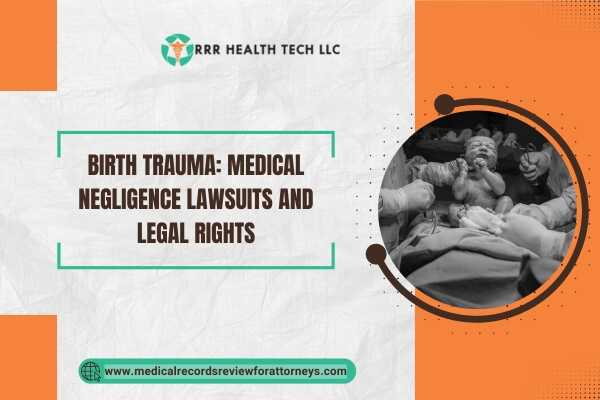
Overview of Birth Trauma
● Birth Trauma sustained during birth will inflict physical, psychological, and economic hardship on both infants and mothers, sometimes for a very long period.
● For parents who are contemplating suing a hospital or health care provider, having an understanding of the legal ramifications of these issues is important
● This article will focus on the details surrounding traumatic birth injuries, their legal scope regarding suing someone, and how medical record examinations aid in fortifying these disputes
Defining Traumatic Birth Trauma
Definition and Examples of Traumatic Birth
● Traumatic birth is the medical term used to describe physical damage inflicted upon a mother or the child during the delivery stage.
● Examples of traumatic birth injuries may involve the following:
● Brachial Plexus Injury: This is typically the result of shoulder dystocia and is the injury to the arm’s controlling network of nerves.
● Fractures or breaks, especially those of the arm or the clavicle
● Cephalohematoma: This is bleeding in the space between the skull and the periosteum, usually caused by forceps.
● Maternal Injuries like a perianal tear or a rupture of the uterus
Reasons for Traumatic Birth
● some of the general reasons for Birth Trauma are:
● Misuse of Delivery Instruments like Forceps or Vacuum Extractors.
• Not Monitoring Fatal Distress: Ignoring warning signs during pregnancy can lead to serious issues.
• Inadequate or Excessive Timed Actions: Not acting in times of crisis or acting at the wrong time.
Legal Actions against a Hospital for Birth Trauma
Case Components of Medical Malpractice
If you want to file a lawsuit concerning a traumatic birth injury, these components need to be proven:
Duty of Care
• All healthcare professionals should legally maintain a defined level of care that is prevalent within the medical field.
Duty of Breach:
• A breach happens when the practitioner does not perform the prescribed actions like negligence of use of wrong methods.
Causation
• There must be a direct ‘nexus’ or link of the breach of duty and any damage that is sure to be caused.
Damages
• The plaintiff must prove that they sustained losses such as undue medical costs, emotional trauma, and sides of earning.
Statute of Limitations
• Every region has its own period in which a particular case/default can be lodged. This period is set at a range of 1 – 3 years from the moment in which the injury happened.
The Role of Medical Records Review in Birth Trauma
Importance of Medical Records
• Medical records play an essential role in proving the following:
• Patient history
• Treatment protocols followed
• Outline of the delivery
How We Assist Attorneys
• Comprehensive Reviews: We provide detailed medical record analyses, including identifying gaps that neglectful parties were negligent.
• Expert Testimony: Our professional opinions can be offered to legal counsel as supporting evidence claims or in bringing the necessary documentation to support their arguments
Case Studies
Case Study 1: Careless Brachial Plexus Injury
• Overview: A mother went through a traumatic delivery that resulted in a significant force being used during delivery and as a consequence her child suffering from brachial plexus injury.
• Challenges: Proving that the healthcare provider took substandard steps regarding care prolonging his care.
• Solutions: A systematic scan of medical documents revealed lack of monitoring and improper use of instruments for delivery
• Compensation: The family was compensated with a settlement that included medical assistance, therapy, counselling and grief endured
Case Study 2: Delivery of Fractured Clavicle
• Overview: An infant underwent an undeserved fractured clavicle and sustaining it during birth as a result of excessive force used in delivery due to the use of a forceps.
• Challenges: Demonstrating that the implementation of forceps was unnecessary and poorly performed.
• Solutions: Medical documents suggested that a proper evaluation had not been conducted prior to the application of forceps, which substantiated the allegations of negligence.
• Compensation: The family was compensated for the medical expenses and additional therapy required.
Conclusion
The implications of severe birth trauma for mothers and infants are interlinked, and legally, a path must be defined for the impacted families. Parents equipped with adequate medical documentation alongside sound legal representation stand better prepared to navigate a malpractice case. Understanding the signs and chronic potential ligations of medical negligence has proven helpful in the pursuit of justice.
